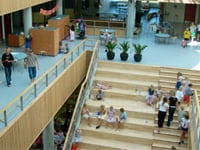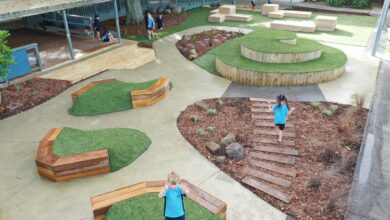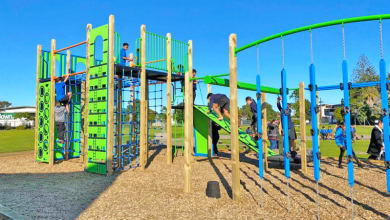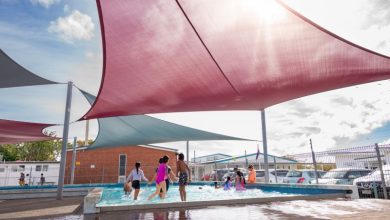The Acoustics of Open-Plan Learning Spaces (or: How I learned to stop worrying, and acknowledge Collaborative Design)

 Twelve years ago I began researching the acoustics of primary school classrooms.
Twelve years ago I began researching the acoustics of primary school classrooms.
This work has mainly centred on identifying the acoustical needs of children, and the design parameters that should be put in place to meet these needs.
I have not been alone in this. Many researchers world-wide have been beavering away observing schools, conducting experiments, interviewing teachers, measuring noise levels etc. What it basically boils down to, after some gross generalisation, is this: build a classroom well away from noisy roads, install a decent acoustic ceiling and a quiet ventilation system (if applicable)… and you will have a pretty good learning environment. The Ministry of Education’s ‘Designing Quality Learning Spaces: Acoustics’ guide is a useful document in this regard. I you haven’t yet, I suggest you read it.
The game has started to change though, and open plan classrooms are coming back into fashion, having been tried and failed in the 1970’s. An open-plan learning space is essentially a classroom block with multiple learning spaces that have no walls between them. Their purpose is to provide a dynamic and effervescent learning environment that promotes interactive learning between the kids.
On paper, they are an acoustic nightmare. There are two main reasons for this:
• Sound transmits between learning spaces so pupils may find it difficult to hear their teacher or become distracted by what’s going on next door
• Large spaces generally have higher reverberation. Excessive reverberation degrades speech intelligibility, meaning the pupils cannot hear what the teacher is saying
If you had asked me even three years ago, I would have said that open-plan learning spaces are quite simply a bad idea… but then I visited one that worked better than I thought they could.
Hellerup School in Copenhagen, Denmark is an architecturally designed (by Arkitema Architects) open-plan learning facility for both primary and secondary children, built in 2002. At the core of its philosophy is the belief that it brings the classroom of the future into the world of today. Children plan their own lessons, use smartphones and WiFi abundantly and are free to occupy any and every space in the school at any time, including outside.
I visited Hellerup as part of an Acoustic conference last year, and it certainly created a stir among the delegates. Some embraced the concept and agreed that it was indeed the next step in educational evolution, while others dismissed it as another failed experiment. Having started my visit as a skeptic, I came away finding myself positioned somewhere in the middle – which leads me to the point of this article – I think open-plan learning spaces can work acoustically provided they are not treated like normal classrooms.
The most remarkable thing about Hellerup School was the commitment of the staff to the open learning approach. They believed in it, and were determined to make it work because they believed in it. This meant changing the way they taught, their expectations of the students and crucially, their use of the school environment. Expecting an open-plan learning environment to support traditional teaching methods is doomed to failure, but if the teaching methods change…
I think Hellerup could indeed have been a failed experiment, but for one crucial thing – there was an acoustician on board from the beginning of the project, and he has had continued involvement since its opening to refine and modify the school as more was discovered about the acoustical pitfalls of open-plan learning. He gave the guided tour of Hellerup himself and was quite clear that there had been teething problems. The acoustic design had undergone several redevelopments – particularly adding acoustic absorption to control reverberation and providing specific spaces for didactic communication i.e. catering for both new and traditional teaching styles.
In summary, despite my background in designing optimum classroom acoustics, I’ve come to understand that an open-plan learning environment can be made to be acoustically acceptable – note I said acceptable, not ideal… but it’s better than what I would’ve said a few years ago!
Establishing a diligent design process that (and here’s the important bit…) includes collaboration between the school, architect, educationalist and acoustician, with agreement on how the various spaces around the school are to be used, is essential in delivering open-plan learning spaces that work.
By James Whitlock, an acoustician with Marshall Day Acoustics









